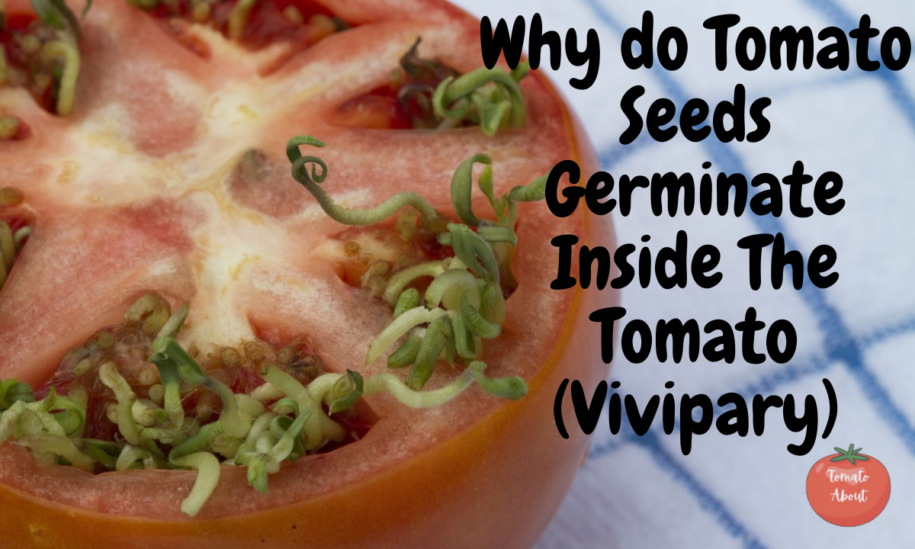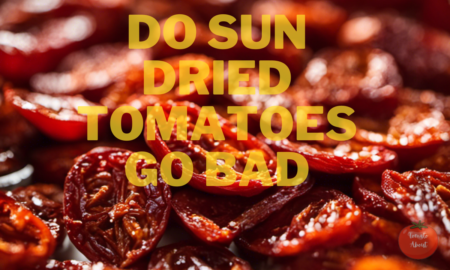Imagine this: you are standing in your garden, and looking at the vibrant red tomatoes that are hanging from the vines you’ve cultivated. As you reach out to pluck one, your fingers brush against something unexpected – A little wiggly green or white thing. is this a worm or something strange?
Luckily, these are not worms but Tomato Seeds Germinate Inside The Tomato. I am pretty sure that you must wonder how this happens. Well, fear not! I have got the answer for you. So Keep reading to learn about it!
So, why do tomato seeds germinate inside a tomato?
Well, this phenomenon is known as vivipary, and it occurs due to a combination of various factors. One key factor is the hormone imbalance within the fruit as it reaches maturity. As the tomato ripens, the hormone which is responsible for preventing germination, abscisic acid, decreases while gibberellin, simultaneously a growth-promoting hormone, increases. This hormonal shifting triggers the seeds to germinate prematurely. The seeds inside a tomato are more likely to sprout if the tomato is exposed to prolonged cold (for about 3-4 days and below 55 degrees Fahrenheit) and then left in a warm place.
Additionally, some other factors like the moist and nutrient-rich environment inside the tomato provide an ideal setting for germination to take place. The combination of hormonal changes and favorable conditions prompts some tomato seeds to begin sprouting while still inside the fruit.
Vivipary in Tomatoes
The seed-sprouting phenomenon has a more general name, called “vivipary”, Which means “live birth” in Latin. According to Wikipedia, Vivipary is a phenomenon in which seeds germinate prematurely while still attached to the parent plant, resulting in the development of seedlings within the fruit itself.
According to the research conducted by North Carolina State University Extension, a lack of abscisic acid can occur due to the following conditions:
Overripe or Ripe Fruits: Overripe or fully ripe fruits are more susceptible to vivipary. As the fruit starts to break down, it releases substances that encourage seed germination.
Genetic Mutations: Mutations in genes that are responsible for ABA biosynthesis, transport, or signaling can lead to reduced or impaired ABA production in tomatoes.
Nutrient Imbalances: Imbalances in essential nutrients, particularly potassium(due to soil depletion) and Nitrogen(over-fertilization), can disrupt ABA synthesis and signaling. Adequate nutrient availability is necessary for proper hormone production and function.
Cold Stress: Low temperatures(Prolonged exposure to temperatures at or below 55 degrees Fahrenheit (12.8 degrees Celsius) also lead to a decrease in abscisic acid levels.
when the tomatoes have Insufficient levels of abscisic acid, it can lead to the phenomenon of seeds sprouting within the tomato itself, and starting growth. Surpursily, these sprouted seeds can even grow to a size where they can rupture the tomato’s skin, and give rise to an entirely new plant. However, this process hinges on the requirement of seed dormancy being overcome. While these sprouts can be grown into new tomato plants, they won’t exactly resemble the parent plant
Seed dormancy refers to the phase during which the seed remains in a state of suspended growth. So, Rather than actively growing, a dormant seed conserves its resources and nutrient and prepares for germination when environmental conditions become more favorable.
Consider the life cycle of a tomato seed. During cold weather, the seed enters a period of dormancy to avoid premature sprouting, a strategy as frost and freezing temperatures can spell defeat for occurring tomato seedlings. As the heat of spring arrives, showing in more hospitable temperatures, the dormant state of tomato seed is abandoned, allowing it to break dormancy and start germination, delegation upon the presence of optimal conditions.
Usually, the seeds retained within a tomato remain dormant throughout the fall and winter seasons. Yet, a deficiency in abscisic acid has the potential to trim this dormancy prematurely, which can potentially trigger seed sprouting even while they are still nestled within the confines of the tomato fruit.
How to Prevent Tomato Seeds from Sprouting Inside the Tomato
Seeds sprouting inside the tomato is a very rare occurrence, but can become common under certain conditions, However, there are a few steps you can take to help prevent this from happening.
- Harvesting at the right time: Make sure to Harvest your tomatoes at the right stage of maturity. As mentioned above, Overripe tomatoes are more prone to seed germination inside the fruit. Therefore, the best time to harvest is when the tomatoes have fully developed their color and are firm to the touch. This reduces the chance of immature seeds sprouting prematurely.
- Seedless or Low-Seeded Varieties: Choose those tomato varieties that are naturally low in seed content or labeled as “seedless.” on the packet. These varieties have fewer seeds, which decrease the chances of sprouting seed inside the fruit. Cherry and grape tomato varieties often have fewer seeds compared to larger beefsteak types.
- Fruit Storage Conditions: After harvesting, make sure to Store your harvested tomatoes in a cool, dry place with good ventilation. Try to Avoid storing them in overly humid or damp environments, as excess moisture can trigger seed germination. A temperature range of 50-55°F (10-13°C) is considered ideal for preventing sprouting.
- Store Upside Down: Storing tomatoes upside down can help prevent seeds from sprouting is another effective approach. This technique capitalizes on the natural tendency of seeds to settle toward the bottom of the fruit. you can eventually minimize the chances of seed germination by storing the tomatoes with the stem end facing downward,
- Seed Removal Before Storage: If you’re concerned about seeds sprouting, you can remove them from the tomatoes before storage. Cut the tomatoes in half horizontally and gently scoop out the seeds with a spoon. Be careful not to damage the inner flesh. Once the seeds are removed, you can store the tomato halves in an airtight container in the refrigerator. This method guarantees that no seeds will be left to germinate.
Are sprouted tomatoes edible?
Tomato sprouts, also known as cotyledons or germinated seeds are the initial growth that appears from the tomato seed during germination. These sprouts are usually pale and have tiny leaves, and are a natural part of the seed’s development process. According to some gardening enthusiasts, Sprouted tomatoes are generally safe to eat, but still, I recommend you avoid consuming them, and here’s why:
- Alkaloid Content: Tomatoes belong to the Solanaceae family, which is also known as the nightshade family. Some plants in this family contain alkaloids, natural chemical compounds that have toxic properties in high concentrations. Solanine is One well-known alkaloid found in nightshades. While tomatoes contain very low levels of alkaloids, the sprouts that emerge from tomato seeds have slightly higher concentrations of solanine due to the early growth stage.
- Unpleasant Taste and Texture: Despite gaining positive experiences from Extension.org, and low alkaloid content, tomato sprouts have an unpleasant taste and texture. They could be bitter, astringent, or have a slightly odd flavor. This can detract from the overall enjoyment of your dish, which is why most people prefer to remove them before consuming tomatoes.
- Cultural Practices: Traditional culinary practices and advice have generally discouraged the consumption of tomato sprouts. These practices have likely developed over time due to the reasons mentioned above. People tend to focus on eating the mature, ripe, and flavorful parts of the tomato plant, which are the fruits themselves.
- Limited Nutritional Value: Tomato sprouts are in their early growth stage and don’t offer the same nutritional profile as mature tomatoes. As plants grow, their nutrient composition changes. While mature tomatoes are rich in vitamins, minerals, and antioxidants, the sprouts might not provide the same level of nutritional benefit.
while there’s no scientific evidence that tomato sprouts are harmful, it’s a generally accepted practice to remove and discard them before consuming tomatoes. This is mainly due to the potential presence of alkaloids, the potential for an off-putting taste and texture, and the limited nutritional value of the sprouts.
Can you eat a tomato if its sprouts have broken the skin?
Well, in that case, the condition is quite different, but there are several factors to consider before deciding whether to consume it. Although it is generally safe to eat a tomato in this condition, yet there are potential quality and safety implications that you should keep in mind. Tomatoes sprouts breaking the skin can affect the tomato’s taste and texture, potentially causing it to become softer and altering its flavor. Moreover, there’s an increased risk of bacterial contamination and spoilage due to compromised skin.
Microorganisms can enter through the openings created by the sprouts, especially if the tomato was stored in a warm or humid environment. This might not only impact the taste but also pose health concerns.
If you really want to choose tomato with sprouts that have broken through the skin, tou need to take few precautions.
First, carefully inspect the tomato for any signs of mold, mushiness, or an unpleasant odor around the sprouted area. If any of these issues are present, then better discard the tomato to avoid potential health risks. Alternatively, if only a small portion of the tomato is affected by the sprouting, you can simply cut away the compromised area and use the rest.
Wash the tomato thoroughly under running water before consumption to remove any surface contaminants
Additionally, it’s important to use the tomato promptly as The compromised skin can accelerate spoilage, so minimizing the time it spends uneaten can help mitigate this risk.
Why Do Seeds Not Germinate in the Fruit?
Seeds usually do not germinate inside the fruit due to a combination of factors that inhibit the germination process until the conditions are right for the plant to grow successfully. These factors include the fruit’s protective mechanisms, the absence of necessary environmental cues, and the energy conservation strategy of the plant.
- Protective Mechanisms: The fruit serves as a protective enclosure for the seeds. the seeds are shielded from external environmental conditions such as light, temperature changes, and potential predators While present inside the fruit.This protection ensures that the seeds do not germinate prematurely when the conditions is not ideal for the young plant’s survival.
- Environmental Cues: Many seeds require specific environmental cues to trigger germination, such as light, temperature fluctuations, or exposure to moisture. These cues signal to the seed that the conditions are favorable for growth.
- Energy Conservation: Plants have evolved strategies to maximize their chances of successful reproduction. Allowing seeds to germinate inside the fruit might waste energy and resources if the conditions are not conducive to the young plant’s survival. By inhibiting germination until the seeds are released from the fruit and exposed to suitable conditions, the plant conserves its resources and increases the chances of successful germination.
- Competition: If seeds within a fruit were to germinate simultaneously, they might compete with each other for resources like water, nutrients, and space. By delaying germination until the seeds are dispersed from the fruit, the plant can promote a more even distribution of its offspring and reduce intra-species competition.
Conclusion
Now, I hope you get the idea of what causes Tomato Seeds to Germinate Inside The Tomato. You also know which conditions inside a warm tomato are perfect for tomato seeds to sprout.
I hope you like this article, do share. If you want to add something, write in a comment.



